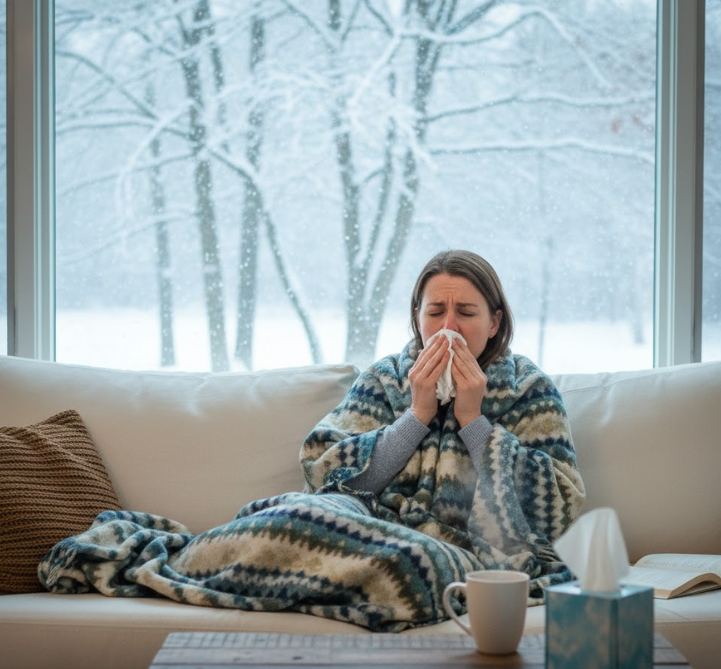Winter in North America: What You Need to Know Is in the Air
When the temperatures drop and the snow begins to fall, so too does our guard against invisible intruders in the air around us. Winter in North America is more than just cold fronts and cozy nights — it’s also peak season for respiratory and gastrointestinal infections that thrive in cool, dry conditions. From influenza and COVID-19, to RSV and norovirus, these pathogens spread rapidly when we spend more time indoors, close windows, and share enclosed spaces. Understanding how these diseases interact with the human immune system is key to protecting ourselves — and at Kraken Sense, it’s what drives our mission to make invisible threats visible.
Influenza: The Ever-Changing Classic
Influenza, or the flu, remains one of the most widespread winter illnesses, infecting the nose, throat, and lungs. It spreads easily — through the air when someone coughs or sneezes, or from contaminated surfaces. Because influenza viruses mutate frequently, the immune system’s antibodies from prior infections or vaccines don’t always recognize new strains. This constant evolution, known as antigenic drift, means our immunity needs to be renewed each year with updated vaccines (Government of Canada, 2025).
Once inside the body, influenza viruses primarily infect epithelial cells in the respiratory tract. The immune system’s innate defenses — including mucus barriers and pattern recognition receptors like TLRs (Toll-like receptors) and RIG-I — are the first to detect viral RNA. These receptors trigger an interferon response, alerting neighboring cells to mount an antiviral state. The adaptive immune system follows, producing targeted antibodies and memory cells for future defense — though the virus’s high mutation rate often outpaces these protections (van de Sandt, Kreijtz, & Rimmelzwaan, 2012).
Flu prevention remains straightforward: annual vaccination, proper hygiene, and staying home when ill. For those over 65 or with weakened immunity, influenza can cause severe complications — a reminder that small viruses can have large impacts when immune defenses falter.
COVID-19: The Evolving Contender
While no longer a novel threat, COVID-19 continues to circulate seasonally, often resurging in colder months when indoor transmission is easier. The SARS-CoV-2 virus enters the body through the eyes, nose, or mouth, using its spike proteins to attach to ACE2 receptors on respiratory cells. Once inside, it hijacks cellular machinery to replicate — damaging tissues and triggering an immune response that, in severe cases, can become overactive, leading to cytokine storms and inflammation throughout the body.
Cold, dry winter air also dries out mucous membranes, reducing the body’s natural ability to trap and clear viral particles. Combined with decreased ventilation and more indoor gatherings, the risk of transmission rises.
Psychologically, colder weather may even skew our perception of risk — studies suggest that when people feel cold, they tend to misjudge disease danger, a phenomenon linked to attribute substitution in cognitive decision-making. Whether perceived or real, this heightened sense of vulnerability often mirrors how respiratory viruses truly behave: thriving in environments where the immune system is slightly less vigilant (Li, 2023).
Vaccination, masking in crowded indoor settings, and adequate ventilation remain effective strategies to minimize spread during the winter wave.
RSV: The Quiet Threat to All Ages
Respiratory Syncytial Virus (RSV) is a winter regular — often peaking in December and January alongside influenza. For most healthy adults, RSV causes mild cold-like symptoms. But in infants, older adults, and immunocompromised individuals, it can progress to bronchiolitis or pneumonia.
RSV targets the same epithelial cells that line the respiratory tract, triggering an intense mucus and inflammatory response. In infants, small airways can become blocked, making breathing difficult. The immune system’s reaction — dominated by neutrophils, cytokines, and interferons — can ironically worsen inflammation while trying to clear the infection (CDC, 2025).
The virus spreads through respiratory droplets and contaminated surfaces, and because nearly all children encounter RSV by age two, lifelong partial immunity is common — but not protective against reinfection. Fortunately, new RSV vaccines and monoclonal antibodies are emerging to protect high-risk populations.
Norovirus: The Winter “Stomach Flu”
Norovirus, sometimes called the “winter vomiting disease,” is a highly contagious gastrointestinal virus that sweeps through schools, care homes, and cruise ships each winter. Though unrelated to influenza, it earns its nickname for its seasonal timing and intensity.
Norovirus spreads via direct contact, contaminated surfaces, or infected food — particularly raw shellfish from polluted waters. The virus can persist on surfaces for days and withstand many disinfectants, making outbreaks difficult to control.
Once ingested, norovirus targets cells in the small intestine, damaging the lining and disrupting fluid absorption. The immune system responds by producing IgA antibodies in the gut, but immunity is short-lived and strain-specific. Because of its genetic variability, reinfection is common — and outbreaks can move through communities with stunning speed (Toronto Public Health, 2025).
The best defense remains frequent handwashing, surface disinfection (especially with chlorine bleach solutions), and avoiding food preparation while ill.
Finding Immunity in the Cold
Though influenza, COVID-19, RSV, and norovirus differ in biology and symptoms, they share one critical trait — they exploit weakened immune defenses during the colder months. Winter air is typically drier, our mucous membranes thinner, and our vitamin D levels lower due to reduced sunlight exposure — all factors that can hinder immune responses. In addition, we spend more time indoors, where air circulation is poor and viral particles linger.
Our bodies fight these infections through intricate immune networks — innate recognition, cytokine signaling, and adaptive antibody formation — but each pathogen has evolved ways to evade or outpace these defenses. Understanding these interactions is key to predicting and preventing outbreaks before they spread.
How Kraken Helps You Stay Ahead of What’s in the Air
At Kraken Sense, we believe that detection is the first line of defense. The KRAKEN system is an automated qPCR platform that brings laboratory-grade precision into a self-contained, field-deployable unit. Designed for reliability in real-world environments, KRAKEN automates every step of the molecular workflow — from sample collection to nucleic acid purification, amplification, and detection — without the need for manual intervention or specialized training.
All analyses are monitored and displayed in real time, with data instantly transmitted to the Kraken dashboard. Through a secure cloud connection, users can view and interpret results from any device — phone, tablet, or computer — in real time..
By detecting outbreaks days to weeks before clinical cases surge, KRAKEN empowers decision-makers to respond early — reinforcing public health measures, focusing vaccination campaigns, and preventing large-scale transmission.
As seasonal viruses circulate through the air, rapid detection becomes critical. The KRAKEN system delivers automated molecular analysis and real-time results, giving communities the data they need to respond before infections spread.

